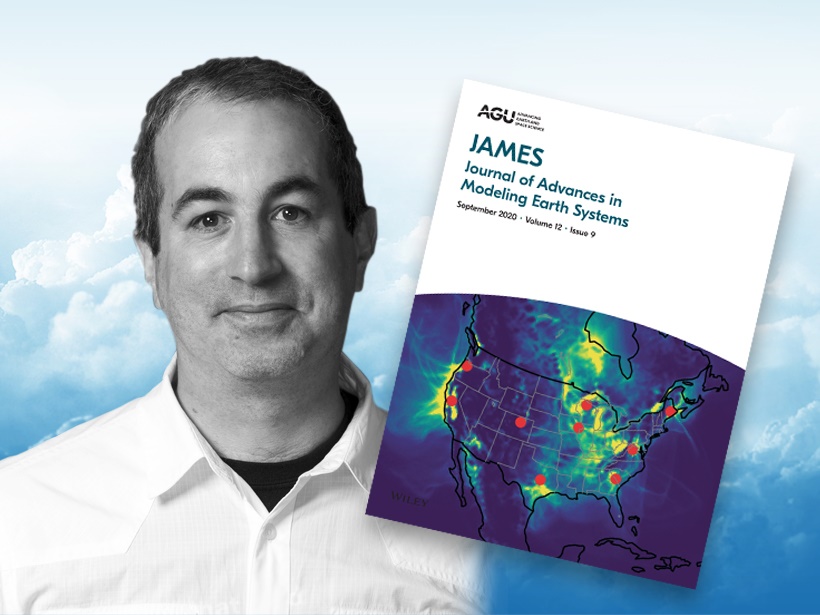Maybe I’m loopy with Covid fatigue, but I’ve been thinking recently that journals are like the lunchrooms we shared in The Time Before – places where an ever-changing group of people gather to talk about things that interest them, building on the conversation from day to day. The Journal of Advances in Modeling Earth System (JAMES) is the table where people talk about models. The conversation is interesting in part because the word is so rich in meaning.
What we talk about when we talk about modeling
Science advances as a dialog between perception and conception. Models bridge these ways of understanding.
Science advances as a dialog between perception – the behavior we notice in the world – and conception – our ideas about the way the world works. Models bridge these ways of understanding. In the earth sciences models are often used to create proxies for observations in a system that isn’t amenable to direct experimentation (incoming JAMES Editor in Chief Stephen Griffies describes this well in his editorial).
Many experiments, and many of practical tasks of prediction, require comprehensive models of the earth system and the machinery to provide initial conditions. But deeper understanding thrives on simplification, and idealized models are key to identifying the essential elements giving rise to a phenomenon and to identifying surprises. Models, in other words, embody ideas, and the practice of modeling encompasses both the posing and the answering of questions.
A lot has happened in the twelve years since JAMES was founded by Prof. David Randall, and even in the six years since I took the role of Editor in Chief. Climate modeling centers around the world participated in a large set of coordinated experiments; the descriptions of the models assembled to do these calculations led to nine special collections in JAMES alone. Ever-increasing computational capacity has permitted calculations of stunning ambitions, such as global forecasts with kilometer scale resolution, even as the character of hardware advances has changed as Moore’s law reached its limits. As in nearly every other aspect of earth science the increasing availability of software tools and specialized hardware for machine learning has provided fertile ground in applications ranging from the modeling of vastly under-resolved processes to making complete weather predictions with statistical models. What remains the same is the journal’s focus on models-as-ideas and the goal of making a home for work that broadly advances the practice of modeling.
Works in progress
The lunch table conversation about ideas is expressed in the textual and visual languages of the words and graphics. But science thrives on evidence, especially evidence that others can build on. AGU has been among the leaders in developing standards for making this evidence more uniformly and equitably accessible by seeking to make data in publications more (findable, accessible, interoperable, and reusable).
There’s no doubt that asking authors to prepare and organize data prior to publication is an added burden. There’s equally little doubt that investing this time is valuable.
There’s no doubt that asking authors to prepare and organize data prior to publication is an added burden. There’s equally little doubt that investing this time is valuable: “data available on request” doesn’t scale, and your future self (or your future colleague) will be grateful for guidance. But modeling studies present a special challenge – models range in degrees of openness; raw data can be too large to distribute and of limited utility; and access to models and data doesn’t guarantee reproducibility.
Helping sometimes reluctant authors find the right balance is the single most fractious and difficult editorial task. The scientific community, including practitioners, publishers, and funding agencies, will need to develop realistic expectations, principles, and resources to support authors in providing data for modeling studies.
Communities thrive on connections, which favor looking in, but also on the creative stirring of new ideas and viewpoints from outside. During my tenure at JAMES I was able to both grow and diversify the editorial board, but that work has further to go. I look forward to seeing an ever-wider range of faces around the table as Stephen Griffies takes over as Editor in Chief.
It takes a village
Though authors and reviewers have just a few points of contact, JAMES runs effectively because of dedicated effort by devoted staff at AGU. It has been a pleasure and an honor to work with Edith Judd, Erin Syring, Paige Wooden, Randy Townsend, Lorraine Hall-Petty, Jeanette Panning, Matt Giampoala, and Brooks Hanson.
The generosity of peer reviewers remains inspiring on a daily basis.
The scientific landscape at JAMES has been cultivated by an extraordinary group of volunteers who have somehow made time away from their own work to enrich the work of others. I have read of order a thousand reviews in the last six years; the generosity of peer reviewers remains inspiring on a daily basis.
My warmest thanks go to those who have served on the editorial board at JAMES during the last six years including editors Paul Dirmeyer, Eleanor Blyth, and Stephen Griffies, and associate editors Milija Zupanski, Steve Krueger, Minghua Zhang, Mikhail Ovchinnikov, Alistair Adcroft, Dick Dee, Marika Holland, Christine Delire, Thorsten Mauritsen, Chris Bretherton, David Nolan, Yongjiu Dai, Wei Ren, Peter Caldwell, Julie Lundquist, Sophie Nowicki, Kei Yohimura, Analisa Bracco, Cecila Bitz, Andreas Oschiles, Juliana Dias, Hui Wan, Florian Lemarié, Tijana Jancic-Pfander, Natasha MacBean, Patrick Laloyaux, and Michael Pritchard.
—Robert Pincus ([email protected]; ![]() 0000-0002-0016-3470), outgoing Editor in Chief of JAMES, University of Colorado, and NOAA Physical Sciences Lab
0000-0002-0016-3470), outgoing Editor in Chief of JAMES, University of Colorado, and NOAA Physical Sciences Lab
Citation:
Pincus, R. (2021), The past, present, and future at JAMES, Eos, 102, https://doi.org/10.1029/2021EO155145. Published on 02 March 2021.
Text © 2021. The authors. CC BY-NC-ND 3.0
Except where otherwise noted, images are subject to copyright. Any reuse without express permission from the copyright owner is prohibited.

